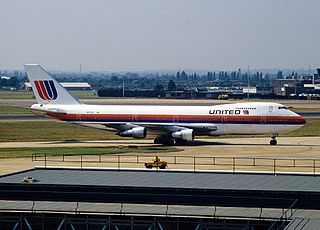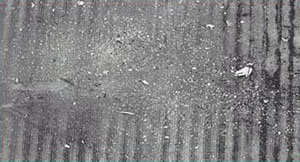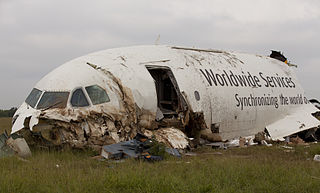Related Research Articles
Atlas Air, Inc. is a major American cargo airline, passenger charter airline, and aircraft lessor based in Purchase, New York. It is a wholly owned subsidiary of Atlas Air Worldwide Holdings. Atlas Air is the world's largest operator of the Boeing 747 aircraft, with a total fleet of 54 of this specific fleet type. In 2021, the airline had 4,056 employees and operated to more than 300 global destinations.

Flash Airlines Flight 604 was a charter flight provided by Egyptian private charter company Flash Airlines. On 3 January 2004, the Boeing 737-300 that was operating the route crashed into the Red Sea shortly after takeoff from Sharm El Sheikh International Airport, killing all 135 passengers, most of whom were French tourists, and all thirteen crew members. The findings of the crash investigation were controversial, with accident investigators from the different countries involved unable to agree on the cause of the accident.

A flight recorder is an electronic recording device placed in an aircraft for the purpose of facilitating the investigation of aviation accidents and incidents. The device may often be referred to as a "black box", an outdated name which has become a misnomer—they are now required to be painted bright orange, to aid in their recovery after accidents.

United Airlines Flight 585 was a scheduled passenger flight on March 3, 1991 from Denver to Colorado Springs, Colorado, carrying 20 passengers and 5 crew members on board. The plane experienced a rudder hardover while on final approach to runway 35 at Colorado Springs Municipal Airport, causing the plane to roll over and enter an uncontrolled dive. All 25 people onboard were killed.

On December 28, 1997, United Airlines Flight 826 was operated by a Boeing 747-100 flying from New Tokyo Airport, Japan to Honolulu International Airport, Hawaii. Two hours into the flight, at an altitude of 31,000 feet (9,400 m), the plane received reports of severe clear-air turbulence in the area and the seat belt sign was turned on. Moments later, the aircraft suddenly dropped around 100 feet (30 m), seriously injuring 15 passengers and 3 crew members. The plane turned around and landed safely back in Tokyo, but one passenger, a 32-year-old Japanese woman, died.

American Eagle Flight 4184, officially operating as Simmons Airlines Flight 4184, was a scheduled domestic passenger flight from Indianapolis, Indiana to Chicago, Illinois, United States. On October 31, 1994, the ATR 72 performing this route flew into severe icing conditions, lost control and crashed into a field. All 68 people aboard were killed in the high-speed impact.

The Hawker Siddeley HS-121 Trident is a British airliner produced by Hawker Siddeley. In 1957, de Havilland proposed its DH.121 trijet design to a British European Airways (BEA) request. By 1960, de Havilland had been acquired by Hawker Siddeley. The Trident's maiden flight happened on 9 January 1962, and it was introduced on 1 April 1964, two months after its main competitor, the Boeing 727. By the end of the programme in 1978, 117 Tridents had been produced. The Trident was withdrawn from service in 1995.

British Airways Flight 38 was a scheduled international passenger flight from Beijing Capital International Airport in Beijing, China, to London Heathrow Airport in London, United Kingdom, an 8,100-kilometre trip. On 17 January 2008, the Boeing 777-200ER aircraft operating the flight crashed just short of the runway while landing at Heathrow. No fatalities occurred; of the 152 people on board, 47 sustained injuries, one serious. It was the first time in the aircraft type's history that a Boeing 777 was declared a hull loss, and subsequently written off.
During the 1990s, a series of issues affecting the rudder of Boeing 737 passenger aircraft resulted in multiple incidents. In two separate accidents, pilots lost control of their aircraft due to a sudden and unexpected rudder movement, and the resulting crashes killed everyone on board, 157 people in total. Similar rudder issues led to a temporary loss of control on at least one other Boeing 737 flight before the cause of the problem was ultimately identified.

EgyptAir Flight 990 (MS990/MSR990) was a regularly scheduled flight from Los Angeles International Airport to Cairo International Airport, with a stop at John F. Kennedy International Airport, New York City. On October 31, 1999, the Boeing 767-300ER operating the route crashed into the Atlantic Ocean about 60 miles (100 km) south of Nantucket Island, Massachusetts, killing all 217 passengers and crew on board.

XL Airways Germany Flight 888T (GXL888T) was an acceptance flight for an Airbus A320 on 27 November 2008. The aircraft crashed into the Mediterranean Sea, 7 km off Canet-en-Roussillon on the French coast, close to the Spanish border, killing all seven people on board.

USAir Flight 427 was a scheduled flight from Chicago's O'Hare International Airport to Palm Beach International Airport, Florida, with a stopover at Pittsburgh International Airport. On Thursday, September 8, 1994, the Boeing 737 flying this route crashed in Hopewell Township, Pennsylvania while approaching Runway 28R at Pittsburgh, which was at the time USAir's largest hub.

British Airways Flight 268 was a regularly scheduled flight from Los Angeles to London Heathrow. On February 20, 2005, the innermost left engine burst into flames triggered by an engine compressor stall almost immediately after take off from LAX. The 747-400 continued to fly across the United States, Canada, and the Atlantic Ocean with its three remaining engines despite air traffic controllers expecting the pilots to perform the emergency landing at the airport. The flight then made an emergency landing at Manchester Airport, citing insufficient usable fuel to reach London Heathrow.

Provincetown-Boston Airlines Flight 1039 was a scheduled passenger flight from Jacksonville International Airport in Jacksonville, Florida, to Tampa International Airport, Florida. On December 6, 1984, the plane crashed upon takeoff at Jacksonville, killing all 13 passengers and crew.

UPS Airlines Flight 1354 was a scheduled cargo flight from Louisville, Kentucky, to Birmingham, Alabama. On August 14, 2013, the Airbus A300 flying the route crashed and burst into flames short of the runway on approach to Birmingham–Shuttlesworth International Airport. Both pilots were pronounced dead at the scene of the crash. They were the only people aboard the aircraft. It was the second fatal air crash for UPS Airlines.

British Airways Flight 2276 was a scheduled international passenger service from Las Vegas to London. On 8 September 2015, the Boeing 777-200ER operating the flight suffered an uncontained engine failure and fire in the left (#1) GE90 engine during take-off from Las Vegas-McCarran International Airport, prompting an aborted take-off and the evacuation of all passengers and crew. All 170 people on board survived, but 20 were injured.

Atlas Air Flight 3591 was a scheduled domestic cargo flight under the Amazon Air banner between Miami International Airport and George Bush Intercontinental Airport in Houston. On February 23, 2019, the Boeing 767-375ER(BCF) used for this flight crashed into Trinity Bay during approach into Houston, killing the two crew members and single passenger on board. The accident occurred near Anahuac, Texas, east of Houston, shortly before 12:45 CST (18:45 UTC). This was the first fatal crash of a Boeing 767 freighter.

Delta Air Lines Flight 30 was a scheduled international passenger flight from Atlanta, Georgia, to London, England. On April 18, 2018, the Airbus A330-323 operating the flight experienced an engine fire after takeoff from Atlanta. The aircraft immediately returned to Atlanta and made an emergency landing. All 288 people on board survived without any injuries. However, the aircraft was substantially damaged, and the National Transportation Safety Board (NTSB) classified the event as an accident. This accident occurred one day after Southwest Airlines Flight 1380 also experienced an engine failure, albeit more severe which depressurized the cabin and killed a passenger.

Tower Air Flight 41 was a scheduled domestic passenger flight from John F. Kennedy International Airport (JFK) in New York City, to Miami International Airport (MIA) in Florida. On December 20, 1995, the Boeing 747-100 operating the flight veered off the runway during takeoff from JFK. All 468 people on board survived, but 25 people were injured. The aircraft was damaged beyond repair and written off, making the accident the 25th hull loss of a Boeing 747. The National Transportation Safety Board (NTSB) concluded that the captain had failed to reject the takeoff in a timely manner.
References
- 1 2 "Advisory Circular - Flight Operational Quality Assurance" (PDF). U.S. Department of Transportation - Federal Aviation Administration. 4 December 2004. p. 5. Archived from the original (PDF) on 12 July 2019. Retrieved 10 October 2011.
- 1 2 "Micro Quick Access Recorder" (PDF). L-3 Communications. Archived from the original (PDF) on 3 March 2012. Retrieved 10 October 2011.
- ↑ "Teledyne Controls Announces Successful Launch of Wireless GroundLinkTM". Teledyne. 5 September 2001. Archived from the original on 24 September 2001. Retrieved 10 October 2011.
- ↑ Efforts to Implement Flight Operational Quality Assurance Programs. General Accounting Office. December 1997. p. 4. Retrieved 10 October 2011.
- ↑ "NTSB Home". www.ntsb.gov. National Transportation Safety Board. Retrieved 2020-05-20.
- ↑ Equinox - "The Box", Channel 4, 2001.